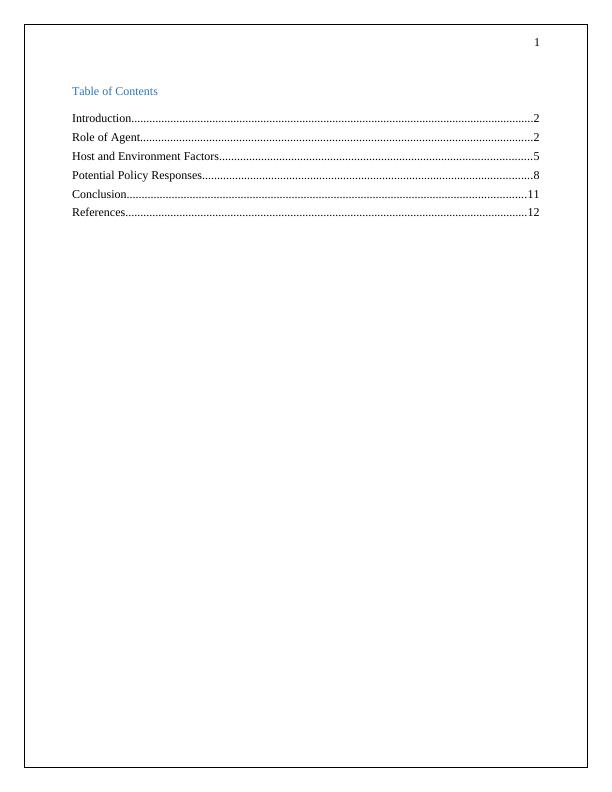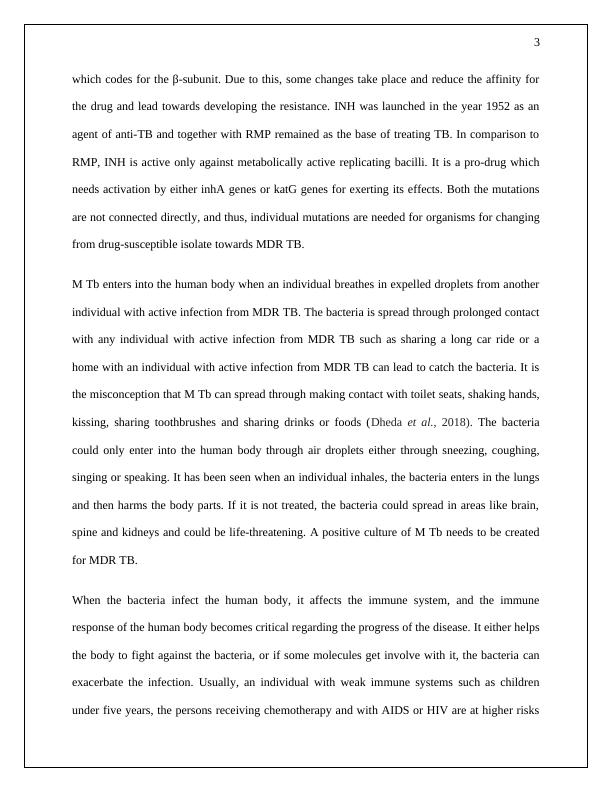MDR Tuberculosis: Role of Agent, Host and Environment Factors, and Potential Policy Responses
Added on 2022-10-04
16 Pages4507 Words224 Views
MDR Tuberculosis
Student's Name:
Student's ID:
Student's Name:
Student's ID:

1
Table of Contents
Introduction......................................................................................................................................2
Role of Agent...................................................................................................................................2
Host and Environment Factors........................................................................................................5
Potential Policy Responses..............................................................................................................8
Conclusion.....................................................................................................................................11
References......................................................................................................................................12
Table of Contents
Introduction......................................................................................................................................2
Role of Agent...................................................................................................................................2
Host and Environment Factors........................................................................................................5
Potential Policy Responses..............................................................................................................8
Conclusion.....................................................................................................................................11
References......................................................................................................................................12

2
Introduction
MDR Tuberculosis (MDR TB) is a particular type of TB which does not respond to the treatment
of TB. The bacteria of TB infect those persons who are resistant to two medicines, isoniazid as
well as rifampicin. Consequently, it becomes difficult for them to treat and need specialized
treatments. The paper will analyze the role of agent connected with MDR TB. It will also
evaluate the host and environmental factors related to the disease. Moreover, it will provide
potential policy responses for the treatment of MDR TB for helping the people to deal with the
impact of the disease.
Role of Agent
The Tuberculosis (TB) is a vital infectious disease and also public health concern all over the
world. The emergence of drug resistance has worsened the situation since, from the year 2012,
more than 450,000 cases of MDR TB and almost 170,000 people have died due to MDR TB. It is
caused by the bacteria known as Mycobacterium Tuberculosis (M Tb) which are resistant to
isoniazid (INH) and rifampicin (RMP) that are the two vital drugs used for treating the disease
(Ahmad Khan et al., 2016). One of the key factors is that the early detection of drug resistance in
TB can reduce and minimize the spreading of this disease.
RMP was launched in the year 1972 as an agent of anti-TB and is one of the most effective
antibiotics for anti-TB and along with INH makes the base of regimen for multidrug treatment
for tuberculosis (Bonnet et al., 2016). RMP is active against both non-growing as well as
growing bacilli. The action mode of RMP in M TB is by binding to β-subunit of the RNA
polymerase. Most of RMP-resistant medical isolates of M Tb harbor mutations in the rpoB gene
Introduction
MDR Tuberculosis (MDR TB) is a particular type of TB which does not respond to the treatment
of TB. The bacteria of TB infect those persons who are resistant to two medicines, isoniazid as
well as rifampicin. Consequently, it becomes difficult for them to treat and need specialized
treatments. The paper will analyze the role of agent connected with MDR TB. It will also
evaluate the host and environmental factors related to the disease. Moreover, it will provide
potential policy responses for the treatment of MDR TB for helping the people to deal with the
impact of the disease.
Role of Agent
The Tuberculosis (TB) is a vital infectious disease and also public health concern all over the
world. The emergence of drug resistance has worsened the situation since, from the year 2012,
more than 450,000 cases of MDR TB and almost 170,000 people have died due to MDR TB. It is
caused by the bacteria known as Mycobacterium Tuberculosis (M Tb) which are resistant to
isoniazid (INH) and rifampicin (RMP) that are the two vital drugs used for treating the disease
(Ahmad Khan et al., 2016). One of the key factors is that the early detection of drug resistance in
TB can reduce and minimize the spreading of this disease.
RMP was launched in the year 1972 as an agent of anti-TB and is one of the most effective
antibiotics for anti-TB and along with INH makes the base of regimen for multidrug treatment
for tuberculosis (Bonnet et al., 2016). RMP is active against both non-growing as well as
growing bacilli. The action mode of RMP in M TB is by binding to β-subunit of the RNA
polymerase. Most of RMP-resistant medical isolates of M Tb harbor mutations in the rpoB gene

3
which codes for the β-subunit. Due to this, some changes take place and reduce the affinity for
the drug and lead towards developing the resistance. INH was launched in the year 1952 as an
agent of anti-TB and together with RMP remained as the base of treating TB. In comparison to
RMP, INH is active only against metabolically active replicating bacilli. It is a pro-drug which
needs activation by either inhA genes or katG genes for exerting its effects. Both the mutations
are not connected directly, and thus, individual mutations are needed for organisms for changing
from drug-susceptible isolate towards MDR TB.
M Tb enters into the human body when an individual breathes in expelled droplets from another
individual with active infection from MDR TB. The bacteria is spread through prolonged contact
with any individual with active infection from MDR TB such as sharing a long car ride or a
home with an individual with active infection from MDR TB can lead to catch the bacteria. It is
the misconception that M Tb can spread through making contact with toilet seats, shaking hands,
kissing, sharing toothbrushes and sharing drinks or foods (Dheda et al., 2018). The bacteria
could only enter into the human body through air droplets either through sneezing, coughing,
singing or speaking. It has been seen when an individual inhales, the bacteria enters in the lungs
and then harms the body parts. If it is not treated, the bacteria could spread in areas like brain,
spine and kidneys and could be life-threatening. A positive culture of M Tb needs to be created
for MDR TB.
When the bacteria infect the human body, it affects the immune system, and the immune
response of the human body becomes critical regarding the progress of the disease. It either helps
the body to fight against the bacteria, or if some molecules get involve with it, the bacteria can
exacerbate the infection. Usually, an individual with weak immune systems such as children
under five years, the persons receiving chemotherapy and with AIDS or HIV are at higher risks
which codes for the β-subunit. Due to this, some changes take place and reduce the affinity for
the drug and lead towards developing the resistance. INH was launched in the year 1952 as an
agent of anti-TB and together with RMP remained as the base of treating TB. In comparison to
RMP, INH is active only against metabolically active replicating bacilli. It is a pro-drug which
needs activation by either inhA genes or katG genes for exerting its effects. Both the mutations
are not connected directly, and thus, individual mutations are needed for organisms for changing
from drug-susceptible isolate towards MDR TB.
M Tb enters into the human body when an individual breathes in expelled droplets from another
individual with active infection from MDR TB. The bacteria is spread through prolonged contact
with any individual with active infection from MDR TB such as sharing a long car ride or a
home with an individual with active infection from MDR TB can lead to catch the bacteria. It is
the misconception that M Tb can spread through making contact with toilet seats, shaking hands,
kissing, sharing toothbrushes and sharing drinks or foods (Dheda et al., 2018). The bacteria
could only enter into the human body through air droplets either through sneezing, coughing,
singing or speaking. It has been seen when an individual inhales, the bacteria enters in the lungs
and then harms the body parts. If it is not treated, the bacteria could spread in areas like brain,
spine and kidneys and could be life-threatening. A positive culture of M Tb needs to be created
for MDR TB.
When the bacteria infect the human body, it affects the immune system, and the immune
response of the human body becomes critical regarding the progress of the disease. It either helps
the body to fight against the bacteria, or if some molecules get involve with it, the bacteria can
exacerbate the infection. Usually, an individual with weak immune systems such as children
under five years, the persons receiving chemotherapy and with AIDS or HIV are at higher risks

End of preview
Want to access all the pages? Upload your documents or become a member.
Related Documents
Causes & Effects of MDR TB | Assignment Heplg...
|8
|1913
|46
Study of Different Diseases: Vaccines, Side Effects, and Treatmentlg...
|8
|1821
|66
Essay on Causes of MDR-TB Docslg...
|8
|1766
|614
Finding a Therapy Option for MDR TBlg...
|15
|3875
|484
Microbiology New Zealand Discussion 2022lg...
|13
|3342
|23
Overview Of The Incidence Tuberculosis in Indialg...
|16
|1893
|21
